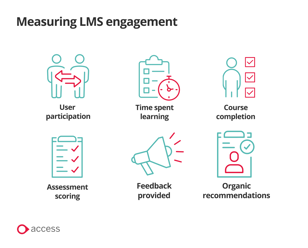 Access Learning
Access Learning
How to supercharge your LMS user engagement: Top Tips for 2025
Once you've selected a Learning Management System (LMS) tailored to your organisation's requirements, it becomes crucial to gauge the levels of user engagement it brings. Understanding this engagement includes both the system and how users interact with it. This involves assessing uptake of mandatory training requirements for employees while also measuring their inclination towards wider learning initiatives, such as training they choose to undertake.
By delving into these aspects, organisations can effectively encourage greater user engagement with their LMS. Strengthening engagement will benefit both the employee and organisation so it should be on your radar when looking at ways to improve your learning offering.
In this article we are going to explore:
Why is LMS engagement important?
Firstly, let’s look at why LMS engagement is important. For any size organisation, employee training is vital and user engagement is a measure of how effectively the training is being delivered. For mandatory topics such as Health & Safety and Cyber Awareness, it is especially important for users to complete them in a timely manner and absorb the information effectively. When regulations are being updated on a frequent basis, an effective online solution will encourage users to stay up to date in line with these changes.
A high level of LMS engagement is a key performance indicator that learning objectives are being met. Seeing positive results with employees engaging enthusiastically with the learning management system will show to stakeholders and decision makers within your organisation that it is a worthy investment going forward. For decisions regarding L&D budgets and where spend should be allocated, these kind of conversations are valuable.
When courses or activities are proactively chosen rather than being assigned to staff, they are more likely to be motivated and engage in the learning process. This will result in a higher level of knowledge retention and a greater ability to apply the newly acquired skills and knowledge in their job role. This can ultimately lead to improved job performance, job satisfaction, and career growth opportunities. By delivering personalised learning experiences through user segmentation, you empower employees to take ownership of their development, fostering a culture of continuous learning and growth.

What features should be included to promote LMS user engagement?
You are likely asking the question “How can we encourage our staff to use the LMS and complete training on a regular basis?” which will have brought you to this article. While it likely involves a bigger conversation than ensuring your users have certain tools at their disposal, it is important that some features are included within your solution to encourage user engagement.
Below are some examples of what should be included and how it can help with engagement in learning.
Gamified Learning
Using elements of gameplay as part of learning and development strategy can be a great way to get users involved in fun and interesting learning.
This can include quizzes and games which encourage friendly competition. As an example, Gamebrain is part of the Access LMS Evo's offering, and is our market-leading gamified learning solution offering short, effective bursts of training in interactive ways.
Bitesize and mobile content
With the pace of the world these days, it can be tricky to fit in dedicated time towards L&D.
To combat this, offering a mobile app that includes bitesize content will make it far easier for users to squeeze some training in to a short block of free time.
Progress tracker
Utilising visuals to demonstrate learning progress, such as completion scoring is a great way to provide motivation to employees.
It will help them to set clear objectives which can then be reviewed on a regular basis. If there are areas that are lacking, this can be explored further for continuous improvements.
A variety of media
People learn in different ways—some prefer visual content (videos, infographics), others engage better with written material (blogs, articles), and some enjoy auditory learning (podcasts, voiceovers). Offering a mix ensures that all types of learners are catered to.
Presenting information in different formats helps reinforce key messages and keeps the user experience dynamic and engaging.
Not only will it likely enhance retention of topics, it can also accommodate different ways of learning and combat fatigue.
Content created with SME’s
Presenting accurate and up-to-date training content will ensure learners are taking in the correct information – which is where subject matter experts can assist. Not only does this add credibility to the eLearning training material but also ensured it's accurate and aligned with industry standards.
Subject matter experts can provide insights, real-world examples, and case studies that make the content more comprehensive and valuable, going beyond basic or surface-level understanding.
Customised learning journeys
Learning paths within an LMS offer a structured and personalised approach to training, significantly enhancing learner engagement. These paths guide learners through a defined curriculum, ensuring a comprehensive understanding of the subject matter.
This structured approach not only clarifies learning objectives but also allows for targeted training based on individual roles, skill gaps, or career development goals. Customised learning journeys empower learners to progress at their own pace while providing a clear roadmap of their learning progression, sparking curiosity and a sense of accomplishment.
An AI-powered learning assistant
You can encourage engagement in learning by utilising an AI-powered learning assistant on hand to reduce barriers and make training easier to find. For example, if a learner asks an AI assistant “When is my next training due?” or “What training is available on the topic of Upskilling?”, the answer will be available to them immediately, without them needing to search for it.
The value of accessible content
Accessible content within a learning management system is an absolute must when it comes to promoting user engagement. Having this type of content available will make it easier for all learners, including those with disabilities, to both use and engage with the content, promoting a culture of inclusivity and equal opportunities. Below are some examples of accessible features which will encourage engagement:
- Optimisation for mobile and tablet
- Adaptable font sizes
- Visual cues to help navigate content
- Screen reader availability
Making eLearning content accessible is essential to ensure that all employees have equal access to training materials and can participate in the learning process equally. This can lead to improved learning outcomes, an inclusive and diverse workplace culture, and ultimately, better engagement in learning.
At Access, we understand the importance of accessible and inclusive content within an LMS, which is why all of our courses are compliant with the WACG.2 standards and screen reader optimised.
Using learning cultures to encourage LMS user engagement
Emphasising the importance of creating a continuous culture of learning within an organisation will benefit employees in many ways, whilst encouraging LMS engagement which will garner tangible results. This culture of learning is likely to motivate your workforce and encourage them to pursue further learning opportunities beyond mandatory training.
Below are five ways to create a culture of learning and encourage LMS engagement:
- Communicate the importance of learning within the LMS.
If users understand the value continuous learning can bring both professionally and personally, they are more likely to participate in it. - Offer tailored content in line with specific skillsets.
This will encourage users to engage with the learnings within the LMS and want to complete the available training, instead of it feeling like a tick-box exercise. - Encourage social learning.
If users are sharing their positive experiences and personal recommendations with their peers through the LMS, it will cultivate a positive learning culture and encourage others to do the same. - Provide ongoing support.
Helping to navigate the LMS and overcome any challenges they might face when using it will ensure users can get the most out of it to achieve their learning goals. - Take inspiration from marketing
By strategically applying marketing tactics such as segmentation and campaigns, the LMS goes beyond traditional training, transforming it from a requirement into a desirable experience. Learners can be alerted to new modules with handy pop ups, making it a meaningful and engaging experience instead of a tick-boxing exercise.
Need help choosing the right LMS for your business? Our guide has you covered.
How can you measure LMS engagement?
You can measure engagement with your learning management system by using the reporting features which should be offered as part of the package within your chosen LMS software. However, there are different ways you can evaluate how users engage in learning, all with their own merits and intricacies.
- User participation
This is probably the most common measure, showing how many users are participating in the learning process and how frequently they are accessing the content. - Time spent learning
A good way to find out if users are spending the right amount of time within the LMS is by measuring their time spent learning. For mandatory topics, this is important data to have access to as it can inform future decisions regarding how to shape eLearning content. - Course completion
If users are not finishing training courses, there is usually a reason for this. Being able to review course completion rates will give a firm indication of how engaging they are and whether users want to get to the end of it. This is especially important for non-compulsory learning. - Assessment scoring
When users are tested on their learning, not only does it offer them accountability, it also provides useful insights into how information is being absorbed and retained. Similarly to the above point, if users are not scoring highly and failing to pass the assessment, this needs to be looked at. Is the assessment measuring their understanding correctly, or is it not testing them on the right information? - Feedback provided
A great way to get an understanding of user experience is by collating feedback. You can identify areas of improvement, encourage participation and if the feedback is positive, this can help to validate that the LMS is doing what it’s supposed to be and getting the user engagement expected. - Organic recommendations
Tracking and reporting on how many times a course has been recommended organically will show actual user engagement. It will then give course and content builders an idea of what topics are trending and ensure they have more similar content to offer.
By using the above metrics to measure user engagement, you can better understand how what users are getting out of both the platform and content within it. This will then help you identify areas of improvement and ensure the user experience is the best it can be. You might also find our guide to measuring ROI in learning and development of use.

8 questions to ask when looking at improving LMS user engagement
Now we have discussed why LMS engagement is important and how it can be supported and measured, here is a list of questions to consider when trying to encourage staff to engage in learning via an LMS.
- Do the users have time within their work schedule to allocate to their learning and training?
- Are your employees supported in their learning needs, and is a culture of learning fostered within your organisation?
- Can LMS engagement be measured effectively with the use of reporting tools?
- Is it communicated clearly why users should be undertaking the training?
- Are timeframes offered in which the learning must be completed by, and are these appropriate for what is expected within the learning materials?
- Are your employees able to see the progress they are making with their training in a simple and visual way?
- Is the chosen solution easy to use and is training provided to effectively utilise it?
- Does your LMS offer features which encourage user engagement, such as learning paths and clear completion targets?
Final Thoughts
As we have discussed within this article, there are many reasons why LMS user engagement should be prioritised within an organisation. By utilising an LMS which includes tools to provide personalised training recommendations and reduce administrative burden, you can create impactful learning experiences.
Being encouraged to engage in learning practises supports employee retention and job satisfaction, driving workforce excellence. It will also help with cost-based decisions regarding LMS choices and wider conversations about learning priorities.
Manage your learning today!
There are many ways to find out more about Access LMS Evo and how it can drive workforce excellence and supercharge your teams.

Schedule a live demo
Relax and let one of our learning experts showcase the capabilities of Access LMS Evo and find out how it can transform your organisation.
Explore our market-leading LMS
Empower your teams by igniting a joy for learning, through our AI-powered LMS.

Speak to an expert
Chat with one of our learning experts and find out how Access LMS Evo can be tailored to meet the needs of your business, regardless of size.
Related articles you might like

Make learning fun with gamification
Gamified learning is an engaging way of making knowledge stick through gameplay and friendly competition. Find out how Gamebrain can help your organisation.

Effectively plan your FCA compliance training
Find out how planning and monitoring your financial services eLearning can help your organisation remain FCA complaint.

How to use LMS analytics in an effective L&D strategy
Explore how using analytics can help you provide targetted online training across your organisation.

 AU & NZ
AU & NZ
 SG
SG
 MY
MY
 US
US
 IE
IE

